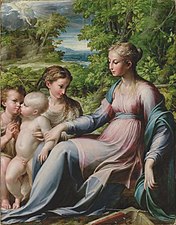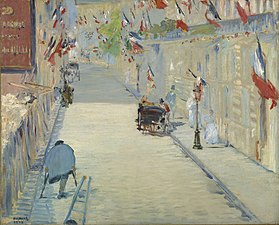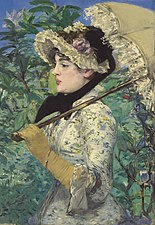J. Paul Getty Museum
| Nom local |
(en) J. Paul Getty Museum
|
|---|---|
| Type |
Musée d'art, maison d'édition
|
| Ouverture |
|
| Visiteurs par an |
2 023 467 ()
|
| Site web |
(en) www.getty.edu/museum
|
| Adresse | |
|---|---|
| Coordonnées |
34° 04′ 39″ N, 118° 28′ 30″ O
|
Le J. Paul Getty Museum est un musée américain situé à Los Angeles en deux sites distincts, le Getty Center et la villa Getty.
Collections
Il abrite la plus grande collections des États-Unis.
Peinture
- Saint Jean-Baptiste avec les prophètes Élie et David, de Luca di Tommè[1]
Objet d'art
- Meuble sculpté dans les années 1880 par Émile Bernard et Paul Gauguin[2].
Galerie
-
Pontormo, Portrait d'un hallebardier (1529-1530).
-
Parmigianino, La Vierge et l'Enfant, Saint Jean Baptiste et Marie Madeleine, vers 1530.
-
Titien, Portrait d'Alfonso d’Avalos, Marchese del Vasto, 1533.
-
Pierre Paul Rubens, La Mise au tombeau, 1612.
-
Orazio Gentileschi, Danaë (en), 1621
-
Rembrandt, Rembrandt riant, 1628
-
Nicolas Poussin, Paysage en temps calme, 1651.
-
Canaletto, Le grand Canal de Venise, vers 1738.
-
Jacques-Louis David, Les sœurs Zénaïde et Charlotte Bonaparte, 1821.
-
Édouard Manet, Portrait de Madame Brunet, 1867.
-
Auguste Renoir, La Promenade, 1870.
-
Claude Monet, Soleil levant (marine), 1872 ou 1873.
-
Vincent van Gogh, Les Iris, 1889.
-
Paul Gauguin, Arii Matamoe (La fin royale), 1892.
-
Paul Cézanne, Nature morte aux pommes, 1893.
Controverse
Les journalistes Jason Felch et Ralph Frammolino publient une enquête dans le Los Angeles Times, pour laquelle ils ont été finalistes 2006 du prix Pulitzer. Ils y « révèlent que la moitié des plus belles pièces antiques du musée sont issues du trafic international ». Parmi les œuvres que dût restituer le musée, il y a l'Aphrodite de Morgantina, acquise pour dix-huit millions de dollars et le cratère d'Astéas, revenu en Italie en 2005[3],[4].
Notes et références
-
Carlo Falciani et Pierre Curie (dir.), La Collection Alana : Chefs-d'œuvre de la peinture italienne, Bruxelles, Fonds Mercator, , 216 p. (ISBN 978-94-6230-154-2)
Ouvrage publié à l'occasion de l'exposition au musée Jacquemart-André du 13 septembre 2019 au 20 janvier 2020, article de Fabiana Carelli, Luca di Tommè , p.87
- Sylvain Alliot, « À la recherche du Paradis Perdu », La Gazette de l'hôtel Drouot, n°44, 7 décembre 2001, p.19.
- (en) Jason Felch et Ralph Frammolino, « The Getty’s troubled goddess », sur www.latimes.com, (consulté le )
- Pascal Corazza, « Un trafic d'experts », Le Monde Diplomatique, no 808, , p. 27 (lire en ligne).
Annexes
Liens externes
-
Notices d'autorité :
- Fichier d’autorité international virtuel
- International Standard Name Identifier
- CiNii
- Bibliothèque nationale de France (données)
- Système universitaire de documentation
- Bibliothèque du Congrès
- Gemeinsame Normdatei
- Bibliothèque nationale de la Diète
- Bibliothèque nationale d’Espagne
- Bibliothèque nationale d’Israël
- Bibliothèque universitaire de Pologne
- Bibliothèque nationale de Catalogne
- Réseau des bibliothèques de Suisse occidentale
- Bibliothèque apostolique vaticane
- Bibliothèque nationale d’Australie
- Base de bibliothèque norvégienne
- Bibliothèque nationale tchèque
- Bibliothèque nationale de Lettonie
- WorldCat
Médias utilisés sur cette page
Portrait of Madame Brunet (also known as Young Woman in 1860), painted in 1860-1863, and reworked by 1867 by Manet, Getty Center
Auteur/Créateur: Pierre Paul Rubens , Licence: CC0
The Entombment, oil on canvas painting by Peter Paul Rubens, c. 1612, Getty Center
To commemorate the recent Exposition Universelle, itself a celebration of luxury and prosperity, the French government declared June 30, 1878, a national holiday. The holiday, called the Fête de la Paix (Celebration of Peace), also marked France's recovery from the disastrous Franco-Prussian War of 1870-1871 and the bloody, divisive Paris Commune that followed. From his second-floor window, Édouard Manet captured the holiday afternoon with his most precise, staccato brushwork in a patriotic harmony of the reds, whites, and blues of the French flag that waves from the new buildings' windows.
The urban street was a principal subject of Impressionist and Modernist painting; many artists aimed to show not only the transformation and growth of the Industrial Age but how it also affected society. Manet's eyes saw both elegant passengers in hansom cabs and, in the foreground, a worker carrying a ladder. The hunched amputee on crutches, perhaps a war veteran or beggar, passes by fenced-in debris left from the construction of a new train track. Manet's sensitivity to the associated costs and sacrifices tempered his optimistic view of national pride and newfound prosperity.
(c) I, Sailko, CC BY-SA 3.0
The outer Peristyle Garden of the Getty Villa Roman gardens, Los Angeles.
The Virgin and Child with Saint Mary Magdalen and the Infant Saint John the Baptist by Parmigianino
Five comedians have just finished their performance in a verdant park on the outskirts of Paris and look expectantly at their audience. Pierrot, the clown in a baggy white suit, is already holding his hat in his hand, hoping that a few coins might be thrown into it.
Flanking Pierrot are four other performers dressed as characters from the Italian commedia dell'arte , which enjoyed great popularity in 18th-century Paris. Brighella wears a splendid greenish-gold suit and shoulder cape trimmed with black stripes. Mezzetin strums a few chords on his guitar, while Harlequin in a black mask with its horsehair eyebrows and moustache peers over his shoulder. A mock Spanish costume of black velvet with a white ruff identifies the figure on the far right as Scaramouche.
The Grand Canal from Palazzo Flangini to Campo San Marcuola, Canaletto, about 1738. The J. Paul Getty Museum, Los Angeles
An aerial view of the Getty Center museum in Brentwood, Los Angeles, viewed from the south.


















































